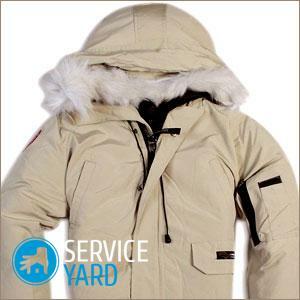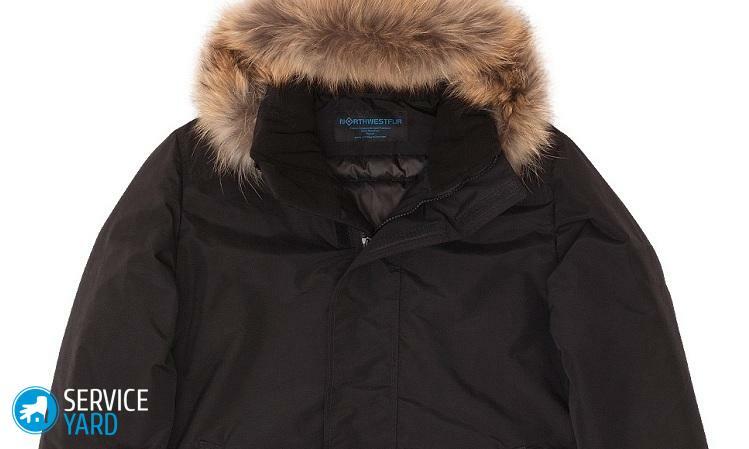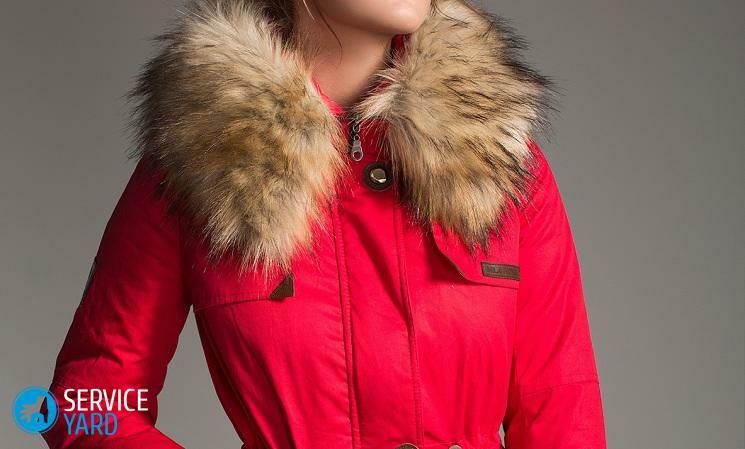
- Natural or artificial?
- Which down is better?
- Synthetic fillers
- Choose a down jacket
Practical, warm, lightweight down jacket - perfect winter clothes. First, it was appreciated by tourists and climbers, who in the middle of the last century wore down jackets made from the most strange, at first glance, materials. Manufacturers of clothing quite quickly oriented, and now offer buyers of very different ages and social status a great many models. What kind of insulation is better for a winter jacket? This will be discussed in our article.
to the contents ↑Natural or artificial?
To choose a down jacket it is necessary to begin with the filler. On the question, the insulation for the jacket - which is better, quite often follows the answer - of course, natural. Is this always so? Natural fluff has, of course, a lot of positive qualities:
- ability to keep heat well;
- lightness.
Yes, but in fact the same qualities are different and artificial materials for filling down jackets! Moreover, sometimes they are even lighter than natural ones, and heat is kept better, at least some.
Cons of natural fluff
The most important drawback of natural fillers is the price. Down jackets in gagach or swan feathers are sometimes very expensive. In addition, there are other disadvantages:
- the complexity of washing;
- need to use waterproof materials for the top and lining;
- ability to cause allergies.

Let's talk about washing
The down jacket with natural filler is very hard to wash in the washing machine:
- The fluff has the property of getting lost and penetrating through the holes in the seams, which adversely affects the performance of your unit.
- If the fabrics, from which the top and lining are sewn, are not of high quality, the fluff is knocked out and through the holes in the weaves.
Important! Before turning on the machine, you need to put a jacket or coat in a special bag - then from fluff there will be much less harm.
After the jacket is washed, you will have to lay it on a horizontal surface. If you try to dry on a rope or even the shoulders - the entire filler will be at the bottom or in the corners. This, of course, is not the problem that will ruin your life forever. But after the product dries, you will have to distribute evenly what is inside it, and slap your favorite thing with the most common carpet punch. Do this sometimes it is necessary and between washing. Therefore, down jackets with natural filler often make quilted. But with artificial material nothing like this will not have to do.
Important! In expensive models, the natural fluff is in special pouches, it does not get as stiff as it is, but it's still necessary to dry on the floor and slam the products.
to the contents ↑Which down is better?
You were not afraid of the upcoming difficulties with washing and yet decided to buy a jacket with natural fluff? Well. Here are the fillers of down jackets - what is better: duck, goose or some other?
Important! Typically, clothing manufacturers use the fluff of water birds, since it does not rot from moisture. But in some cheap Chinese models, there may be a chicken, and this should be abandoned at once - such a down jacket will serve exactly until you get under a cold winter rain. Especially if the top is sewn from a not very high-quality fabric, the manufacturer who allows himself to use such a filler obviously does not care about quality, or offers you not street, but home clothes.
It will not be easy to dry the jacket completely. Much better than fluff:
- Gaga. Gagachi Pooh is the most qualitative, but also the most expensive. Products with such a filler are very warm and very light.
- of the Swan. Swan is also of high quality. Perhaps, it retains heat a little worse, but it is just as light and soft.
Important! If you live in the regions where there are very severe frosts in winter, it is better to choose one of these two options.
Goose and ducks. Jackets on duck and goose down cost a little cheaper. They are heavier and slightly more rigid, but quite warm and are well suited for not particularly cold winters( for example, in regions with a mild marine climate).Northerners, who can not afford a jacket for eiderdown and are forced to settle for a duck, usually sew double-layer down jackets.Important! Those who prefer natural materials, it is better to choose the feather-feather filler - it will last longer.
to content ↑Synthetic fillers
Modern synthetic materials make it possible for even people with a modest budget to dress beautifully, comfortably and up to date. This applies to down jackets.
Artificial fillers in their qualities sometimes surpass natural ones:
- they can better retain heat;
- some of them allow you to feel comfortable, even if after a morning frost the thaw unexpectedly occurred;
- they are easy to wash and dry;
- , many of them do not get lost with time, so you do not need to slap clothes;
- among artificial fillers are those that can serve for decades.
So, if you are looking for the answer to the question, the insulation for a winter coat - which is better, be sure to pay attention to synthetic materials. It can be:
- sintepon;
- synthies;
- issoftware;
- holofiber;
- tinsulate.
New materials appear every year, so do not be surprised if on the label you see some other name. But for now these remain the most popular.
Synthepone
The cheapest and still very fashionable filler. Of course, in recent years, other materials have been fairly pressed, but it has a number of advantages:
- lightness;
- hypoallergenicity;
- ability to retain heat well;
- ability to dry quickly after getting wet or washing;
- does not absorb moisture;
- can be washed in any way, including in the automatic machine;
- can be dried in any position.
Important! The jackets on the sintepon barely weigh anything. This material is absolutely inert, that is, it does not react with the environment, which means it does not emit harmful substances and does not cause allergies. Wash such a thing is a pleasure: no delicate washing is needed, detergents can be used any, and you can dry it even on a battery - the form will not change.
There are, however, a couple of very significant drawbacks, because of which this material gradually comes out of use:
- after washing the jacket will be somewhat blown off:
- after a long sock or a few washings, even a sheet of sintepon, which is usually used, will lump.
Important! A quilted product with a synthetic filler is much more reliable: the material does not lose its lumps and does not lose its volume.

Isosoft
This is a membrane insulator, invented in Europe. He was offered by the company Libeltex, and usually he meets in the clothes of this brand. Undoubted advantages include:
- very small mass;
- almost complete lack of ability to absorb moisture:
- excellent thermal protection qualities:
- the ability to wash in any convenient way;
- durability.
Important! Isosoft easier sintepona, and even more so - natural fluff. It excellently repels moisture, so that the jacket does not get wet even under very heavy rain. For the first time wearing a tonyusky down jacket with this filler, you will be very pleasantly surprised - even in severe frost it will not be cold. You can wash the product as you like - manually, in the automatic machine and even in the activator unit without any additional protection. Dry the jacket will be very fast and in any position.
In addition, issoform:
- does not lose form;
- does not lose volume;
- does not get stuck.
Important! This perfection has only one drawback - it costs almost as much as a down jacket on eider's fluff from a good manufacturer.
Hollofayber
Soft and lightweight stuff, stuffed with toys, mattresses and clothes. Perhaps, for the northern countries - an ideal option, a very reasonable combination of price and quality. If we talk about the pros, they are as follows:
- small weight( heavier than isosofta, but insignificantly);
- does not cause allergies;
- does not absorb water;
- does not lose volume when washing and soaking;
- is inexpensive;
- is found in many models.
Important! However, some users believe that this material does not pass air sufficiently well. But this is confirmed only by those who wore jackets and coats, in which the fabric of the top and the lining of the air is also not passed. Those who wear models of "breathing" materials, this problem does not arise.
Tinsulate
Siliconeized polyester, whose fibers are spirally wound and surrounded by air. They are very thin, about 60 times thinner than the human hair. This material was intended for cosmonauts, but it is also widely used in ordinary clothes. Its advantages:
- is the warmest;
- is the thinnest;
- is the easiest;
- is easily erased;
- does not clump;
- dries very quickly;
- does not react with the environment;
- does not cause allergies;
- does not absorb odors.
There is no perfection in the world, so the Tinsuleith also has drawbacks:
- price;
- body can overheat even in frost;
- accumulates a static charge.
Important! Ideal for regions with a very harsh winter. It is worth it, however, not cheap, but it will serve for many years, even though it can be washed every day - it will not lose form and volume.

Synthesis
As the name implies, this filler is similar in structure to fluff, and by properties - to synthetic fillers. It is really fluff, that is, the bulk mass, but consists of artificial fibers. Fibers spring, intertwine, as a result - a rather dense structure is formed, which provides good thermal insulation.
Important! To fibers do not cling to each other and do not get mixed up, they are treated with silicone.
Advantages of this material are not less than others:
- is not able to react with the environment;
- does not release allergens;
- does not absorb dust;
- does not retain odors;
- features increased durability;
- is not affected by fungus;
- has antiseptic properties;
- transmits air;
- is perfectly dry:
- dries easily.
Choose the down jacket
What to look for in the store, except for the filler? There are several other parameters that must be taken into account:
- weight;
- filler distribution;
- availability of special packages:
- quilted or not;
- cloth upper and lining.
Weight and technology
To keep warm in the down jacket, it should weigh no more than 600 g. This allows you to keep the volume, which means - to provide a good thermal insulation:
- See how evenly distributed the filler is. There should be no clots or bruises.
- The presence of packages is determined only by touch. If the jacket is not quilted, you can easily move the fluff or what it replaces, inside the package - but no further.
- In addition, it should not be pricked.
Standard
Having chosen natural fluff, do not forget to learn about the standard according to which it was processed. The label should be DIN EN 12934. This means that the fluff went through all the steps:
- soaking;
- washing;
- drying;
- filtering;
- sterilization.
Important! Only in this case, a jacket with natural fluff will be worn for a long time. Do not forget to smell the product - it should smell like any new thing, without the admixtures of mustiness and rot.

Seams
Cheap models make quilted, that is, stitched on squares or horizontal stripes. Sometimes expensive down jackets look the same. The difference is determined by touch - yes, it's about the very bags that are in quality products and are not in poor quality.
Important! In any case, pay attention to the seams. They should be smooth, beautiful, without tears and protruding threads. In a cheap quilted down jacket, the filler is directly under the material of the top.
The manufacturing process is simple:
- When sewing, the top and inner parts are quilted along parallel lines, vertical or horizontal.
- Then the pockets are filled with down.
- After that, they are quilted again, but perpendicular to the lines already available - in much the same way as quilting quilts.
Unfortunately, with this technology, fluff very quickly gets knocked off - first "cold spots" are formed, then the entire filler is in the corners. Sacks of special fabric that are used in more expensive models, allow the natural filler to stay in shape longer. In this case, the product itself looks like an ordinary coat or jacket, without additional seams.
Important! Do not forget to check if the fluff is not getting through the holes in the seams. To do this, it is sufficient to bend the product in place of the seam and see if there is such a defect, it will certainly appear.
Fabric
This is a very important point. As a rule, natural fabrics for making this kind of clothes are not used. You can meet:
- synthetic;
- mixed.
On the question of which option is better, there is no definite answer. The presence of natural fibers in mixed fabrics slightly increases the heat-shielding properties. But among the synthetic materials come across those that do not skip moisture, but at the same time "breathe", and this is the best option for winter clothing.
As you can see, to choose a really high-quality down jacket, which will not lose its properties and beauty in one or another season, is not so easy. For this it is necessary not only to understand what kind of insulation is better for a winter jacket, but also to pay attention to other nuances of making things. And which ones - you now know, so you can easily cope with the task of buying a new warm thing. Good luck!



